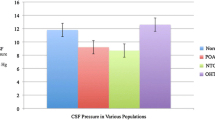Abstract
Translaminar pressure gradient is an important parameter in glaucoma, as optic nerve head is not only affected by intracular pressure and intracranial pressure but also by the thickness of the lamina cribrosa. Indeed, translaminar pressure gradient might be the single most important pressure related parameter for the development and progression of glaucoma.
Access provided by Autonomous University of Puebla. Download chapter PDF
Similar content being viewed by others
Translaminar pressure gradient (TPG) is another important parameter in glaucoma, as optic nerve head is not only affected by intraocular pressure (IOP) and intracranial pressure (ICP) but also by the thickness of the lamina cribrosa. Indeed, TPG might be the single most important pressure related parameter for the development and progression of glaucoma [1, 2]. TPG is defined as the difference between IOP and ICP per unit thickness of the lamina cribrosa [(IOP − ICP)/thickness of the lamina cribrosa] [3]. The ability of the lamina cribrosa to withstand TPG also depends on the surrounding extracellular matrix and the peripheral scleral tension [4]. Furthermore, the inherent heterogeneity of the lamina cribrosa also plays a significant role in determining the distribution of the pressure gradient [5]. The integrity and resilience of the lamina cribrosa in maintaining its shape is extremely important for protecting the health of the structures that pass through it [4, 6].
The thickness of a normal lamina cribrosa is around 450 μm with a calculated TPG of about 1 mmHg per 100 μm [2, 3]. The thinner lamina cribrosa determines a higher TPG and create a steeper path that retrograde axonal transport must traverse. Jonas et al. reported that lamina cribrosa is thinner in myopes and that there are morphometric changes in lamina cribrosa in glaucomatous eyes, including thinning [2, 7]. Interestingly, experimental studies revealed that lamina cribrosa thickens at the earliest stage of glaucoma [8] and getting thinner at advanced stages of glaucoma [9, 10]. This might explain why eyes with advanced glaucomatous damage and thinner lamina cribrosa are at higher risk of progression compared with eyes with mild or moderate disease [11].
References
Burgoyne CF, Downs JC, Bellezza AJ, Suh J-KF, Hart RT. The optic nerve head as a biomechanical structure: a new paradigm for understanding the role of IOP-related stress and strain in the pathophysiology of glaucomatous optic nerve head damage. Prog Retin Eye Res. 2005;24(1):39–73.
Jonas JB, Berenshtein E, Holbach L. Anatomic relationship between Lamina Cribrosa, intraocular space, and cerebrospinal fluid space. Investig Ophthalmol Vis Sci. 2003;44(12):5189–95.
Berdahl JP, Allingham RR. Intracranial pressure and glaucoma. Curr Opin Ophthalmol [Internet]. 2010;21(2):106–11. http://content.wkhealth.com/linkback/openurl?sid=WKPTLP:landingpage&an=00055735-201003000-00004
Marek B, Harris A, Kanakamedala P, Lee E, Amireskandari A, Carichino L, et al. Cerebrospinal fluid pressure and glaucoma: regulation of trans-lamina cribrosa pressure. Br J Ophthalmol [Internet]. 2014;98(6):721–5. http://www.ncbi.nlm.nih.gov/pubmed/24307714
Fleischman D, Berdahl JP. Posterior scleral biomechanics and the translaminar pressure difference. Int Ophthalmol Clin. 2014;54(1):73–94.
Guidoboni G, Harris A, Carichino L, Arieli Y, Siesky BA. Effect of intraocular pressure on the hemodynamics of the central retinal artery: a mathematical model. Math Biosci Eng. 2014;11(3):523–46.
Jonas JB, Berenshtein E, Holbach L. Lamina cribrosa thickness and spatial relationships between intraocular space and cerebrospinal fluid space in highly myopic eyes. Investig Ophthalmol Vis Sci. 2004;45(8):2660–5.
Yang H, Downs JC, Bellezza A, Thompson H, Burgoyne CF. 3-D histomorphometry of the normal and early glaucomatous monkey optic nerve head: prelaminar neural tissues and cupping. Investig Ophthalmol Vis Sci. 2007;48(11):5068–84.
Quigley HA, Addicks EM. Regional differences in the structure of the lamina cribrosa and their relation to glaucomatous optic nerve damage. Arch Ophthalmol (Chicago, IL: 1960). 1981;99(1):137–43.
Quigley HA, Hohman RM, Addicks EM, Massof RW, Green WR. Morphologic changes in the lamina cribrosa correlated with neural loss in open-angle glaucoma. Am J Ophthalmol. 1983;95(5):673–91.
The Advanced Glaucoma Intervention Study (AGIS). 12. Baseline risk factors for sustained loss of visual field and visual acuity in patients with advanced glaucoma. Am J Ophthalmol. 2002;134(4):499–512.
Author information
Authors and Affiliations
Corresponding author
Editor information
Editors and Affiliations
Rights and permissions
Copyright information
© 2019 Springer Nature Switzerland AG
About this chapter
Cite this chapter
Siaudvytyte, L. (2019). Translaminar Pressure Gradient. In: Januleviciene, I., Harris, A. (eds) Biophysical Properties in Glaucoma. Springer, Cham. https://doi.org/10.1007/978-3-319-98198-7_5
Download citation
DOI: https://doi.org/10.1007/978-3-319-98198-7_5
Published:
Publisher Name: Springer, Cham
Print ISBN: 978-3-319-98197-0
Online ISBN: 978-3-319-98198-7
eBook Packages: MedicineMedicine (R0)




